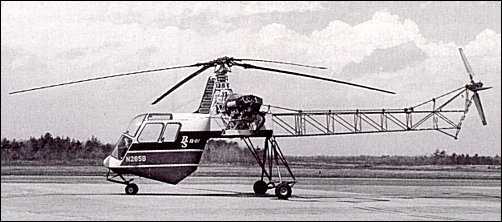|
|
The SG-VI-D did not go into production and Sznycer started a new company, Allied Aero Industries, in the USA to develop and build the Omega BS-12 utility helicopter. This had a flying crane layout, with a forward four-seat crew pod and an open tubular rear fuselage and fixed tricycle undercarriage. A metal cargo box could be suspended beneath the fuselage mid-section. The BS-12 (N267B) used two 210hp Franklin engines positioned end-to-end above the rear fuselage. The prototype flew on 29 October 1956, and was followed by a revised version - the BS-12B (N290B). The Omega design was progressively upgraded with detail design changes, notably to the cabin pod and to the engines. The BS-12D-1 (N285B) had two 260hp Lycoming O-540 engines and a five-seat cabin. The second BS-12D-1 (N286B) was fitted with supercharged Franklin 6AS-335 engines and redesignated BS-12D-3. In 1960, the investors backing the Omega designs withdrew support and further development was terminated. R.Simpson "Airlife's Helicopter and Rotorcraft", 1998
| Technical data for Omega SB-12
Rotor diameter: 11.89m,
fuselage length: 11.12m,
height: 3.96m,
weight empty: 1338kg,
gross weight: 1905kg,
max speed: 138km/h,
service ceiling: 3450m,
range: 250km
|
Warning: mysqli_connect(): php_network_getaddresses: getaddrinfo for mysql5.zone.ee failed: Name or service not known in /data03/virt15346/domeenid/www.aviastar.org/htdocs/helicopters_eng/sznycer_omega.php on line 72
Fatal error: Uncaught mysqli_sql_exception: php_network_getaddresses: getaddrinfo for mysql5.zone.ee failed: Name or service not known in /data03/virt15346/domeenid/www.aviastar.org/htdocs/helicopters_eng/sznycer_omega.php:72
Stack trace:
#0 /data03/virt15346/domeenid/www.aviastar.org/htdocs/helicopters_eng/sznycer_omega.php(72): mysqli_connect('mysql5.zone.ee', 'd14657sa18989', Object(SensitiveParameterValue))
#1 {main}
thrown in /data03/virt15346/domeenid/www.aviastar.org/htdocs/helicopters_eng/sznycer_omega.php on line 72
|





